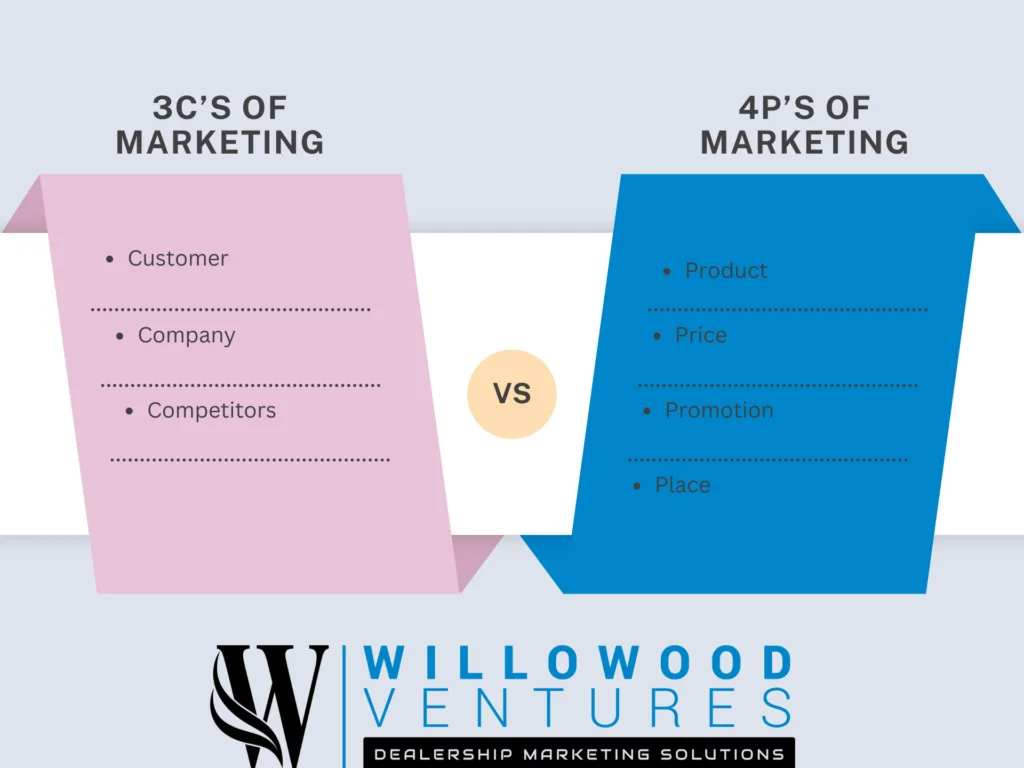3 C’s of Marketing vs 4P’s of Marketing at Willowood Ventures Dealer Services
Table of Contents
ToggleMastering the 3 Cs of Marketing: Your Blueprint for Dominating the Market
In today’s cutthroat business world, you need every edge you can get. Enter the 3 Cs of marketing – a powerful framework that can transform your approach to business strategy and skyrocket your success. Whether you’re a seasoned pro or just starting out, understanding and implementing this model is crucial for staying ahead of the pack.
Let’s dive deep into the 3 Cs and uncover how you can leverage them to crush your competition and drive massive growth.
What Are the 3 Cs of Marketing?
The 3 Cs framework, developed by business strategist Kenichi Ohmae, focuses on three critical elements:
- Customer
- Company
- Competition
By analyzing and aligning these three factors, you create a rock-solid foundation for your marketing strategy. Let’s break each one down in detail.
1. Customer: The Heart of Your Business
Your customer isn’t just important – they’re everything. Without them, you don’t have a business. Period. To win in today’s market, you need to get inside your customer’s head and understand their deepest needs, desires, and pain points. At Willowood Ventures, we’ve seen firsthand how crucial this understanding is for our clients’ success.
Key Questions to Ask About Your Customer:
- Who exactly is my ideal customer? Get specific.
- What keeps them up at night?
- What are their biggest challenges and frustrations?
- What do they really want? (Hint: It’s often not what they say they want)
- How do they make purchasing decisions?
- What’s their buyer’s journey like?
- Where do they hang out online and offline?
- What influences their opinions and behaviors?
Don’t just guess at these answers. You need real data. Here’s how to get it:
Customer Research Tactics:
- Surveys: Use tools like SurveyMonkey or Google Forms to gather quantitative data.
- Interviews: Talk to customers one-on-one to get qualitative insights.
- Social Media Listening: Monitor conversations about your brand and industry on platforms like Facebook.
- Analytics: Dive into your website and sales data to understand customer behavior.
- Customer Service Logs: Analyze support tickets and chat logs for common issues and questions.
The deeper you understand your customer, the easier it becomes to serve them at a high level and crush your competition. Our BDC services can help you gather and analyze this crucial customer data.
2. Company: Leveraging Your Strengths
Next, you need to take a hard look in the mirror and assess your company’s strengths, weaknesses, and unique capabilities. This isn’t the time for ego – you need brutal honesty.
Key Questions to Ask About Your Company:
- What unique value do we bring to the table?
- What are we world-class at?
- Where do we fall short?
- What resources and capabilities do we have?
- What’s our company culture like?
- What’s our brand perception in the market?
- What’s our financial situation?
- What technology and processes do we use?
The goal here is to align your company’s strengths with what your customers actually want and need. Find that sweet spot, and you’ve struck gold.
Tools for Company Analysis:
- SWOT Analysis: Assess Strengths, Weaknesses, Opportunities, and Threats.
- Core Competency Analysis: Identify what you do better than anyone else.
- Value Chain Analysis: Examine how you create and deliver value.
- Employee Surveys: Get insights from your team on company strengths and weaknesses.
- Financial Analysis: Review key performance indicators and financial health.
Remember: You can’t be all things to all people. Focus on what you do best and double down on it. That’s how you create a sustainable competitive advantage. Our targeted email campaigns can help you showcase your unique strengths to potential customers.
3. Competition: Know Your Battlefield
You don’t operate in a vacuum. To win, you need to understand the competitive landscape and how you stack up. This isn’t about obsessing over your competitors – it’s about knowing the battlefield so you can outmaneuver them.
Key Questions to Ask About Your Competition:
- Who are our main competitors?
- What are their strengths and weaknesses?
- How do we differentiate ourselves?
- Where are the gaps in the market we can exploit?
- What’s their pricing strategy?
- How do they market and advertise?
- What’s their market share?
- Are there any emerging competitors or technologies we need to watch out for?
Study your competition relentlessly, but don’t just copy what they do. Find ways to zig when they zag. Carve out your own unique position in the market.
Competitive Analysis Techniques:
- Porter’s Five Forces: Analyze industry competition dynamics.
- Competitor Profiling: Create detailed profiles of key competitors.
- Benchmarking: Compare your performance against industry leaders.
- Mystery Shopping: Experience your competitors’ products or services firsthand.
- Social Media Monitoring: Track competitors’ online presence and engagement on platforms like LinkedIn.
By understanding your competition, you can identify opportunities to differentiate and find underserved niches in the market.
Integrating the 3 Cs: Where the Magic Happens
The real power of the 3 Cs framework comes from integrating all three elements into a cohesive strategy. Here’s a step-by-step process to make it happen:
- Identify customer needs: Use your customer research to pinpoint core desires and pain points.
- Assess your capabilities: Take stock of your company’s strengths and how they align with customer needs.
- Analyze the competition: Study the market and find gaps you can exploit.
- Develop your unique value proposition: Craft an irresistible offer that leverages your strengths to meet customer needs in a way competitors can’t match.
- Create your marketing strategy: Develop a plan to communicate your value proposition to your target audience.
- Align your operations: Ensure your internal processes and resources support your strategy.
- Execute and measure: Put your plan into action and track key performance indicators.
- Iterate and improve: Continuously refine your approach based on results and feedback.
Our Facebook Sales Event strategy is a prime example of how we integrate the 3 C’s to drive results for our clients.
Real-World Example: How Apple Dominates with the 3 C’=s
Apple is a master of the 3 C’=s framework. Let’s break down how they apply it:
Customer:
- Target audience: Tech-savvy consumers who value design, simplicity, and premium experiences.
- Understands customer desire for seamless integration and ecosystem benefits.
- Recognizes customer willingness to pay premium prices for perceived quality and status.
Company:
- Strengths in design, branding, and user experience.
- Robust ecosystem of products and services that work together seamlessly.
- Strong financial position allows for significant R&D investment.
- Exceptional supply chain management and manufacturing capabilities.
Competition:
- Differentiates with focus on premium products and closed ecosystem.
- Maintains higher profit margins compared to Android competitors.
- Leverages brand loyalty to retain customers and drive repeat purchases.
- Continuously innovates to stay ahead of fast-moving tech landscape.
By aligning these elements, Apple has built a loyal customer base, commands premium pricing, and consistently outperforms competitors in profitability and brand value.
Implementing the 3 Cs in Your Business
Ready to put the 3 Cs into action? Here’s a practical game plan:
- Conduct a 3 Cs audit: Set aside time to thoroughly analyze your customers, company, and competition using the questions and tools outlined above.
- Identify gaps and opportunities: Look for misalignments between customer needs, your capabilities, and what competitors are offering.
- Develop your strategy: Create a plan that leverages your strengths to meet customer needs in a unique way.
- Communicate internally: Ensure your entire team understands and buys into the strategy.
- Execute with focus: Implement your plan consistently across all customer touchpoints.
- Measure and adapt: Regularly track key metrics and be willing to adjust your approach based on results.
Need help implementing this strategy? Contact us for a personalized consultation.

Common Pitfalls to Avoid
As you implement the 3 Cs framework, watch out for these common mistakes:
- Ignoring change: Markets evolve rapidly. Regularly reassess all three C’s to stay current.
- Overemphasizing one C: Balance is key. Don’t focus on one element at the expense of the others.
- Analysis paralysis: Don’t get stuck in endless research. Gather enough data to make informed decisions, then take action.
- Copying competitors: Use competitive insights to inform your strategy, not dictate it. Find your own unique position.
- Forgetting internal alignment: Ensure your entire organization is aligned with your 3 C’s strategy.
The Bottom Line: Your Path to Market Domination
The 3 Cs of marketing framework isn’t just theory – it’s a proven blueprint for business success. By deeply understanding your customer, leveraging your company’s strengths, and outmaneuvering the competition, you’ll create an unbeatable market position.
Don’t just read about it. Take action. Carve out time this week to audit your business using the 3 Cs. You’ll uncover insights that transform your entire approach to marketing and strategy.
Remember, this isn’t a one-and-done exercise. The most successful companies continually reassess and refine their approach based on the 3 Cs. Make it a core part of your business planning process, and you’ll stay ahead of the curve in even the most competitive markets.
Ready to take your marketing to the next level? Willowood Ventures specializes in helping dealerships implement powerful frameworks like the 3 C’s to drive massive growth. Call us at 833-735-5998 to learn how we can supercharge your marketing strategy and help you dominate your market.
For more insights and strategies, check out our YouTube channel or schedule a call with one of our experts.
3 Cs - Frequently Asked Questions
How often should I revisit the 3 Cs analysis?
Ideally, conduct a thorough 3 Cs analysis at least annually. However, in fast-moving markets, you may need to reassess quarterly to stay ahead of the curve. Keep a pulse on key indicators and be ready to adapt your strategy as needed.
What if I'm in a highly commoditized market?
Even in commoditized markets, there's always room for differentiation. Focus on superior customer service, unique bundling, innovative delivery methods, or niche specialization to stand out. The key is to find a way to add value that your competitors aren't addressing.
How do I gather competitive intelligence ethically?
Stick to publicly available information like websites, marketing materials, annual reports, and industry publications. Attend trade shows and conferences. Use social media monitoring tools. Never engage in corporate espionage or unethical practices to gain an edge. Your goal is to understand the competitive landscape, not steal trade secrets.
Can small businesses benefit from the 3 Cs framework?
Absolutely. Small businesses often have an advantage in implementing the 3 Cs because they can be more agile and responsive to customer needs. The framework helps small businesses focus their limited resources on the most impactful areas and find unique ways to compete against larger competitors.
How does the 3 Cs framework relate to other marketing models like the 4 P's?
The 3 Cs and 4 P's (Product, Price, Place, Promotion) are complementary frameworks. The 3 Cs help you develop your overall strategy, while the 4 P's guide tactical execution of that strategy. Use the 3 Cs to understand your market position, then apply the 4 P's to create a marketing mix that aligns with your strategic insights.
What are the key components of the 3 Cs model?
The 3 Cs model, developed by Kenichi Ohmae, focuses on three critical elements: Customer, Company, and Competition. By analyzing and aligning these three factors, businesses can create a solid foundation for their strategy and achieve sustainable success.
Why is understanding the customer important in the 3 Cs framework?
The customer is at the heart of the 3 Cs framework. Understanding customer needs, preferences, and pain points enables you to tailor your products, services, and marketing efforts to meet
Discover how we can amplify your dealership’s leads, sales, and profits with expert automotive marketing.
Menu
Service 2025verified by TrustindexTrustindex verifies that the company has a review score above 4.5, based on reviews collected on Google over the past 12 months, qualifying it to receive the Top Rated Certificate.



Copyright © 2025 Willowood Ventures – Terms & Conditions – Privacy
Get Started Today!
Let's drive you more traffic now!


